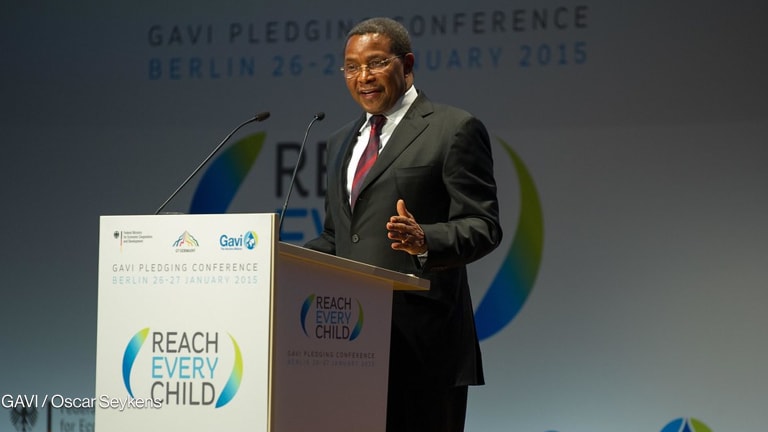
You’ve seen the alarming headlines from around the world: Asia, Europe, Africa, South America, and North America have seen the highest number of measles outbreaks in decades, and this disease once thought eliminated in many parts of the world is coming back with a vengeance.
Why are we seeing such staggering rates of infections — and needless deaths — from a disease for which we have a safe and effective vaccine? Unfortunately, in many parts of the world, fewer children are being vaccinated. In 2017, 11 countries that had previously reached 90 percent diphtheria-tetanus-pertussis vaccine coverage fell below this target, and nearly 20 million children were undervaccinated. This is a worrisome sign we are backsliding in our progress.
Over 1.5 million children die annually from vaccine-preventable deaths.
— UNICEFTo stop measles and other vaccine-preventable diseases in their tracks, we know that countries need to step up their vaccination efforts. While many countries are working to ramp up domestic spending on immunization and health, the international community continues to play an important role. Bill Gates kicked off the year by making a compelling case for global health, including vaccines, describing it as “the best investment” he had ever made.
We need to have robust donor support to multilateral organizations working on immunizations globally in order to keep us on the path to achieving Sustainable Development Goal 3: Health and well-being for all. We have the right collective action tools in our toolbox to ensure no child needlessly gets sick from a disease. Platforms such as Gavi, the Vaccine Alliance, Measles & Rubella Initiative, and Global Polio Eradication Initiative allow for actors committed to immunization to come together to stop these threats to people’s well-being around the world.
We know that this year and next will bring critical funding moments for GPEI and Gavi. Meeting the replenishment needs of our most important platforms for collective action on immunization must remain a top priority for donor governments and other philanthropic partners if we are going to see the tide turn against vaccine-preventable diseases and other threats to the world’s health and well-being.
More on vaccination:
► Why can't pregnant women be vaccinated during epidemics?
► Battle over CEPI's access to vaccines policy deepens
► Can PPPs help ensure vaccine supplies for future global epidemics?
Few expect this task to be easy. Increasing hostility to multilateralism, declining trust in institutions, and nativist and nationalistic turns are becoming more commonplace, including in donor countries that have been the bedrock of financing for multilateral global health efforts for well over a decade.
To counter these impulses, we must come together to support replenishment efforts with a persuasive and compelling vision of the outcomes we will be able to achieve.
It starts with hammering home the message on the progress we’ve already made together. It is telling that the pace of global progress in reducing child mortality was twice as fast during the Millennium Development Goals period than during the ‘90s, and the largest gains came from a reduction in vaccine-preventable diseases, especially measles, pneumonia, and rotavirus.
But as we’ve seen, this progress is fragile and can be easily undone. Most of the world’s underimmunized children live in fragile contexts, including areas that face ongoing humanitarian disaster, conflict, refugee and migrant flows, and poor health infrastructure, so they are unable to access basic health services. Many also face cultural, social, financial, and logistical barriers to immunization.
This is why we must redouble our efforts and work to reaffirm the world’s commitment to global health.
The SDGs provide an opportunity to support comprehensive immunization efforts that will help reduce preventable maternal and child deaths, combat a range of communicable and noncommunicable diseases, advance universal health coverage, and strengthen health systems to benefit individuals during all phases of life. If we succeed, 1.5 million people could be saved each year through better immunization coverage.
The trouble is, despite a period of robust and remarkable growth, concurrent with the progress of the MDGs era, health-focused development assistance has largely flatlined. According to the Institute for Health Metrics and Evaluation, from 2010-2017, it only grew 1 percent. This is a worrisome trend, precisely as global ambition is accelerating toward the SDGs.
The bottom line: Over the next 10 years, it is imperative that countries step up their own domestic resources for health, and receive robust, flexible, and coherent development assistance for health, combined with smart support where they are transitioning from major financial and technical support for health programs.
The October 2018 Global Action Plan for Healthy Lives and Well-being for All has the potential to drive continued, high-level commitment, innovation and coordination across major global health players. It could enhance the effectiveness of external support by fostering collaboration on supply chain efforts, data and monitoring, demand-creation among populations, and domestic resource mobilization.
Domestic financing and development assistance alone will not be enough to meet the challenges ahead. To maintain progress on immunization, build strong health systems and reach the SDG targets, we will need new paradigms of partnership between countries, development partners, and the private sector.
Donors, the private sector, and governments will need to pull together in the same direction in 2019 and make good on the pledge to leave no one behind. Our children and our world are depending on it.








